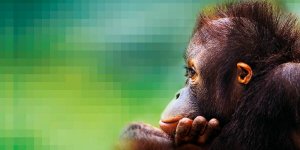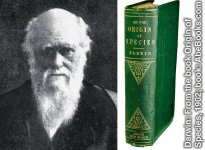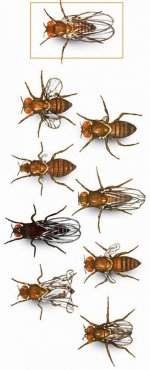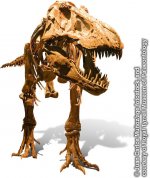- Joined
- Sep 19, 2016
- Posts
- 3,579
- Reaction
- 7,229
- Points
- 2,575

“Evolution is as much a fact as the heat of the sun,” asserts Professor Richard Dawkins, a prominent evolutionary scientist.You do not have permission to view the full content of this post. Log in or register now. Of course, experiments and direct observations prove that the sun is hot. But do experiments and direct observations provide the teaching of evolution with the same undisputed support?
Before answering that question, we need to clear up something. Many scientists have noted that over time, the descendants of living things may change slightly. For example, humans can selectively breed dogs so that eventually the descendants have shorter legs or longer hair than their forebears. You do not have permission to view the full content of this post. Log in or register now. Some scientists attach to such slight changes the term “microevolution.”
However, evolutionists teach that small changes accumulated slowly over billions of years and produced the big changes needed to make fish into amphibians and apelike creatures into men. These proposed big changes are defined as “macroevolution.”

Charles Darwin and his book Origin of Species
Charles Darwin, for example, taught that the small changes we can observe implied that much bigger changes—which no one has observed—are also possible.You do not have permission to view the full content of this post. Log in or register now. He felt that over vast periods of time, some original, so-called simple life-forms slowly evolved—by means of “extremely slight modifications”—into the millions of different forms of life on earth.You do not have permission to view the full content of this post. Log in or register now.
To many, this claim sounds reasonable. They wonder, ‘If small changes can occur within a species, why should not evolution produce big changes over long periods of time?’ You do not have permission to view the full content of this post. Log in or register now. In reality, though, the teaching of evolution rests on three myths. Consider the following.
Myth 1. Mutations provide the raw materials needed to create new species. The teaching of macroevolution is built on the claim that mutations—random changes in the genetic code of plants and animals—can produce not only new species but also entirely new families of plants and animals.You do not have permission to view the full content of this post. Log in or register now.

Mutations can introduce changes in plants—such as this mutant with large flowers—but only within limits
The facts. Many characteristics of a plant or an animal are determined by the instructions contained in its genetic code, the blueprints that are wrapped up in the nucleus of each cell. You do not have permission to view the full content of this post. Log in or register now. Researchers have discovered that mutations can produce alterations in the descendants of plants and animals. But do mutations really produce entirely new species? What has a century of study in the field of genetic research revealed?
In the late 1930’s, scientists enthusiastically embraced a new idea. They already thought that natural selection—the process in which the organism best suited to its environment is most likely to survive and breed—could produce new species of plants from random mutations. Therefore, they now assumed that artificial, or human-guided, selection of mutations should be able to do the same thing but more efficiently. “Euphoria spread among biologists in general and geneticists and breeders in particular,” said Wolf-Ekkehard Lönnig, a scientist from the Max Planck Institute for Plant Breeding Research in Germany. You do not have permission to view the full content of this post. Log in or register now. Why the euphoria? Lönnig, who has spent some 30 years studying mutation genetics in plants, said: “These researchers thought that the time had come to revolutionize the traditional method of breeding plants and animals. They thought that by inducing and selecting favorable mutations, they could produce new and better plants and animals.”You do not have permission to view the full content of this post. Log in or register now. In fact, some hoped to produce entirely new species.

Mutant fruit flies, though malformed, are still fruit flies
Scientists in the United States, Asia, and Europe launched well-funded research programs using methods that promised to speed up evolution. After more than 40 years of intensive research, what were the results? “In spite of an enormous financial expenditure,” says researcher Peter von Sengbusch, “the attempt to cultivate increasingly productive varieties by irradiation [to cause mutations], widely proved to be a failure.”You do not have permission to view the full content of this post. Log in or register now. And Lönnig said: “By the 1980’s, the hopes and euphoria among scientists had ended in worldwide failure. Mutation breeding as a separate branch of research was abandoned in Western countries. Almost all the mutants . . . died or were weaker than wild varieties.” You do not have permission to view the full content of this post. Log in or register now.
Even so, the data now gathered from some 100 years of mutation research in general and 70 years of mutation breeding in particular enable scientists to draw conclusions regarding the ability of mutations to produce new species. After examining the evidence, Lönnig concluded: “Mutations cannot transform an original species [of plant or animal] into an entirely new one. This conclusion agrees with all the experiences and results of mutation research of the 20th century taken together as well as with the laws of probability.”
So, can mutations cause one species to evolve into a completely new kind of creature? The evidence answers no! Lönnig’s research has led him to the conclusion that “properly defined species have real boundaries that cannot be abolished or transgressed by accidental mutations.”You do not have permission to view the full content of this post. Log in or register now.
Consider the implications of the above facts. If highly trained scientists are unable to produce new species by artificially inducing and selecting favorable mutations, is it likely that an unintelligent process would do a better job? If research shows that mutations cannot transform an original species into an entirely new one, then how, exactly, was macroevolution supposed to have taken place?
Myth 2. Natural selection led to the creation of new species. Darwin believed that what he called natural selection would favor those life-forms best suited to the environment, whereas less suitable life-forms would eventually die off. Modern evolutionists teach that as species spread and became isolated, natural selection chose the ones with gene mutations that made them capable of surviving in their new environment. As a result, evolutionists speculate, these isolated groups eventually developed into totally new species.
The facts. As previously noted, the evidence from research strongly indicates that mutations cannot produce entirely new kinds of plants or animals. Nevertheless, what proof do evolutionists provide to support the claim that natural selection chooses beneficial mutations to produce new species? A brochure published in 1999 by the National Academy of Sciences (NAS) in the United States refers to “the 13 species of finches studied by Darwin on the Galápagos Islands, now known as Darwin’s finches.”You do not have permission to view the full content of this post. Log in or register now.
In the 1970’s, a research group led by Peter R. and B. Rosemary Grant of Princeton University began studying these finches and discovered that after a year of drought on the islands, finches that had slightly bigger beaks survived more readily than those with smaller beaks. Since observing the size and shape of the beaks is one of the primary ways of determining the 13 species of finches, these findings were assumed to be significant. “The Grants have estimated,” continues the NAS brochure, “that if droughts occur about once every 10 years on the islands, a new species of finch might arise in only about 200 years.”You do not have permission to view the full content of this post. Log in or register now.
However, the NAS brochure neglects to mention that in the years following the drought, finches with smaller beaks again dominated the population. The researchers found that as the climatic conditions on the island changed, finches with longer beaks were dominant one year, but later those with smaller beaks were dominant. They also noticed that some of the different “species” of finches were interbreeding and producing offspring that survived better than the parents. They concluded that if the interbreeding continued, it could result in the fusion of two “species” into just one.You do not have permission to view the full content of this post. Log in or register now.

At best, Darwin’s finches show that a species can adapt to changing climates
So, does natural selection really create entirely new species? Decades ago, evolutionary biologist George Christopher Williams began questioning whether natural selection had such power.You do not have permission to view the full content of this post. Log in or register now. In 1999, evolutionary theorist Jeffrey H. Schwartz wrote that natural selection may be helping species adapt to the changing demands of existence, but it is not creating anything new.You do not have permission to view the full content of this post. Log in or register now.
Indeed, Darwin’s finches are not becoming “anything new.” They are still finches. And the fact that they are interbreeding casts doubt on the methods some evolutionists use to define a species. In addition, information about these birds exposes the fact that even prestigious scientific academies are not above reporting evidence in a biased manner.
Myth 3. The fossil record documents macroevolutionary changes. The previously mentioned NAS brochure leaves the reader with the impression that the fossils found by scientists more than adequately document macroevolution. It declares: “So many intermediate forms have been discovered between fish and amphibians, between amphibians and reptiles, between reptiles and mammals, and along the primate lines of descent that it often is difficult to identify categorically when the transition occurs from one to another particular species.”You do not have permission to view the full content of this post. Log in or register now.

The facts. The confident statement made by the NAS brochure is quite surprising. Why? Niles Eldredge, a staunch evolutionist, states that the fossil record shows, not that there is a gradual accumulation of change, but that for long periods of time, “little or no evolutionary change accumulates in most species.” You do not have permission to view the full content of this post. Log in or register now.You do not have permission to view the full content of this post. Log in or register now.
According to the fossil record, all the major groups of animals appeared suddenly and remained virtually unchanged
To date, scientists worldwide have unearthed and cataloged some 200 million large fossils and billions of small fossils. Many researchers agree that this vast and detailed record shows that all the major groups of animals appeared suddenly and remained virtually unchanged, with many species disappearing as suddenly as they arrived.
Belief in Evolution—An Act of “Faith”

Why do many prominent evolutionists insist that macroevolution is a fact? Richard Lewontin, an influential evolutionist, candidly wrote that many scientists are willing to accept unproven scientific claims because they “have a prior commitment, a commitment to materialism.” You do not have permission to view the full content of this post. Log in or register now. Many scientists refuse even to consider the possibility of an intelligent Designer because, as Lewontin writes, “we cannot allow a Divine Foot in the door.”You do not have permission to view the full content of this post. Log in or register now.
In this regard, sociologist Rodney Stark is quoted in Scientific American as saying: “There’s been 200 years of marketing that if you want to be a scientific person you’ve got to keep your mind free of the fetters of religion.” He further notes that in research universities, “the religious people keep their mouths shut.”You do not have permission to view the full content of this post. Log in or register now.
If you are to accept the teaching of macroevolution as true, you must believe that agnostic or atheistic scientists will not let their personal beliefs influence their interpretations of scientific findings. You must believe that mutations and natural selection produced all complex life-forms, despite a century of research that shows that mutations have not transformed even one properly defined species into something entirely new. You must believe that all creatures gradually evolved from a common ancestor, despite a fossil record that strongly indicates that the major kinds of plants and animals appeared abruptly and did not evolve into other kinds, even over aeons of time. Does that type of belief sound as though it is based on facts or on myths? Really, belief in evolution is an act of “faith.”
How Would You Reply?
- How would you respond to the claim that proof of so-called microevolution is evidence that macroevolution must have taken place?
- Why is it significant that the fossil record shows that the majority of species changed very little over vast periods of time?
Attachments
-
You do not have permission to view the full content of this post. Log in or register now.